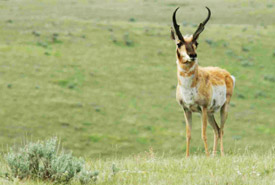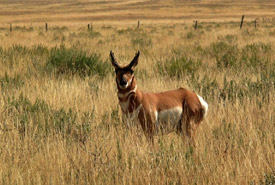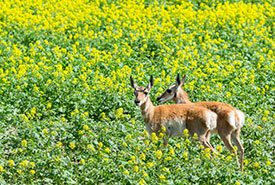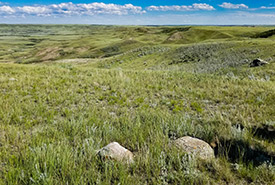Tales of recovery: Pronghorn

Pronghorn antelope, Old Man on His Back (Photo by Karol Dabbs)
Ask a Canadian to name the fastest land animal in the world. Even if they have never watched a nature documentary, they probably know it’s the cheetah. But most Canadians don’t know the planet’s second fastest animal, even though it lives right here.
The pronghorn, often called the pronghorn antelope, although it’s more closely related to giraffes, earns second place with its bursts of speed that can reach almost 100 kilometres per hour. It’s probably so fast because, at one time, there were cheetah-like cats that lived in North America. But these cats were part of the mass extinction of megafauna that happened about 13,000 years ago. That left pronghorns with an acceleration and endurance that could easily beat their remaining predators, such as wolves. But even with their speed, they almost didn’t outrun extinction.
Quick facts at a glance
Status in Canada
1915: near extinction
1938: increasing
Today: secure
What worked?
Rapid response to identify and create new protected areas, hunting restrictions, emergency protected areas
When Europeans first colonized North America, there were an estimated 30 to 40 million pronghorns, vast herds that were only rivalled by plains bison. They also shared the same fate as bison when settlers expanded across the Prairies. They were first shot as a food source and later because many settlers saw them as competition to domestic animals. In addition to over-hunting, habitat loss and poor agricultural practices took a toll, as did the millions of miles of barbed wire that were strung across the Prairies. While pronghorn can dash across the prairie like no other animal, they can’t jump. As they try to crawl through even just a few strands of barbed wire, they can become entangled and die.
As early as 1886, they were gone from Manitoba’s prairies. By 1913, it was predicted that pronghorn would be one of the first species of North American big game to become extinct. Their numbers had dwindled by over 99.9 per cent to a few small scattered herds from Saskatchewan to Mexico. But something was about to happen that would save the species.

Pronghorn in Alberta (Photo courtesy of the University of Calgary)
A bit of national park history
Back in 1911, Canada became the first country in the world to set up a national parks service. The Dominion Parks Branch (now Parks Canada) became instrumental in reversing the decline of many Canadian wildlife species by establishing new parks, including Elk Island (1913) and Wood Buffalo (1922). But while bison and elk could be captured, transported and bred in enclosures, pronghorn often didn’t survive captivity. The parks would need to come to where the last few herds still lived.

Pronghorns (Photo by River Run Photography)
In 1914, Maxwell Graham, head of the Animal Division of the Dominion Parks Branch, and renowned naturalist and writer Ernest Thompson Seton surveyed the Prairies for the last herds. Between 1915 and 1922, three new national parks covering over 235 square kilometres were established to protect pronghorn — Menissawok National Park in Saskatchewan, and Wawaskesy and Nemiskam National Parks in Alberta. Fences were put up to keep them inside these protected areas. Hunting was banned across their range. Conservation efforts moved as fast as pronghorn in what was perhaps one of the most urgent efforts to save a species from extinction in Canada.
These emergency protected areas worked. By 1936, pronghorn numbers and range expanded to the point where the hunting ban in Saskatchewan was lifted. Never heard of those new national parks? That’s because the three “antelope reserves” were dissolved in 1947. Their goal of saving the pronghorn from extinction complete.
Back from the brink
Pronghorn are now considered secure in Canada and the U.S., with an estimated 750,000 adults and a stable population. They are common in many parts of Canada’s prairies and are easy to spot in places that are dominated by natural prairies, such as the Pakowki Lake area in Alberta’s grasslands and Grassland National Park in Saskatchewan. Last fall, one was even spotted in Manitoba for the first time in a century. If populations expand, these rare observations could be common for future generations of Manitobans.
But pronghorn still face many challenges. Their grassland habitats are continuing to be lost and fragmented. The population that lives along the U.S. and Mexican border is at risk of being completely separated. Barbed-wire fences continue to block their movements. Severe droughts and winters can also cause populations to crash.
Across its range, there are many projects that are continuing to help this iconic prairie species. In the U.S., the "Path of the Pronghorn" project is protecting and restoring one of their longest intact migration routes. Drivers can now report pronghorn crossings with an app called Pronghorn Xing to help scientists identify critical migration corridors. New pronghorn-friendly fences are being installed by landowners across the Prairies.

Aire naturelle du bassin de la rivière Milk, Sask. (Photo de CNC)
Protecting pronghorn habitat
The Nature Conservancy of Canada has protected thousands of hectares of native prairie grasslands in key areas for pronghorn and is aiming to ramp up these efforts. Other measures such as wildlife friendly fencing are also implemented. Recently, 578 hectares (1,429 acres) were protected in the Milk River Basin, supported through Canada’s Natural Areas Conservation Program, the Government of Saskatchewan, the U.S. Fish and Wildlife Service and private donors.
Conservation often only moves fast when it’s getting to be too late — when the urgency is undeniable. When an animal like the pronghorn peers over the precipice of extinction. These emergency efforts are critical; we need to applaud them and keep applying them to species that could be lost forever. But we need to couple our emergency efforts with a strong base of proactive conservation. We need to keep common species common and to protect Canada’s plants and animals well before they face imminent extermination.
Resources
Nelson, E.W., Status of the pronghorned antelope, 1922-1924. 1925: US Department of Agriculture.
Buechner, H.K., Life History, Ecology, and Range Use of the Pronghorn Antelope in Trans-Pecos Texas. The American Midland Naturalist, 1950. 43(2): p. 257-354.
Seton, E.T., A list of mammals of Manitoba. 1886: Toronto.
Hornaday, W.T., Our vanishing wild life: its extermination and preservation. 1913: C. Scribner's sons.
Foster, J., Working for wildlife: The beginning of preservation in Canada. 1998: University of Toronto Press.


